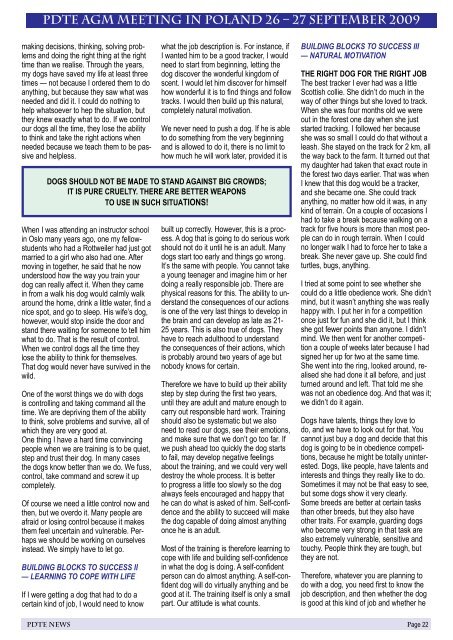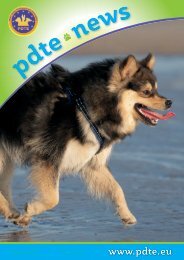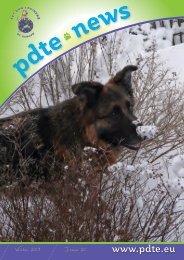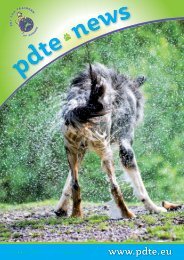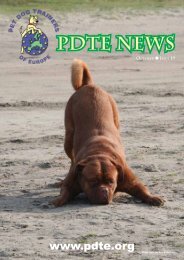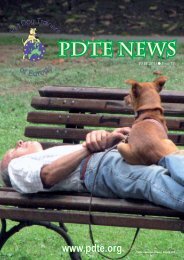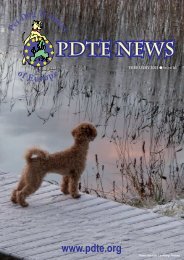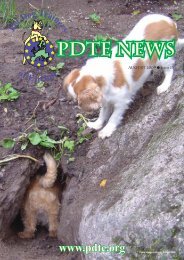PDTE 2010 January Newsletter
You also want an ePaper? Increase the reach of your titles
YUMPU automatically turns print PDFs into web optimized ePapers that Google loves.
<strong>PDTE</strong> AGM MEETING In Poland 26 – 27 September 2009<br />
making decisions, thinking, solving problems<br />
and doing the right thing at the right<br />
time than we realise. Through the years,<br />
my dogs have saved my life at least three<br />
times — not because I ordered them to do<br />
anything, but because they saw what was<br />
needed and did it. I could do nothing to<br />
help whatsoever to hep the situation, but<br />
they knew exactly what to do. If we control<br />
our dogs all the time, they lose the ability<br />
to think and take the right actions when<br />
needed because we teach them to be passive<br />
and helpless.<br />
what the job description is. For instance, if<br />
I wanted him to be a good tracker, I would<br />
need to start from beginning, letting the<br />
dog discover the wonderful kingdom of<br />
scent. I would let him discover for himself<br />
how wonderful it is to find things and follow<br />
tracks. I would then build up this natural,<br />
completely natural motivation.<br />
We never need to push a dog. If he is able<br />
to do something from the very beginning<br />
and is allowed to do it, there is no limit to<br />
how much he will work later, provided it is<br />
DOGS SHOULD NOT BE MADE TO STAND AGAINST BIG CROWDS;<br />
IT IS PURE CRUELTY. THERE ARE BETTER WEAPONS<br />
TO USE IN SUCH SITUATIONS!<br />
When I was attending an instructor school<br />
in Oslo many years ago, one my fellowstudents<br />
who had a Rottweiler had just got<br />
married to a girl who also had one. After<br />
moving in together, he said that he now<br />
understood how the way you train your<br />
dog can really affect it. When they came<br />
in from a walk his dog would calmly walk<br />
around the home, drink a little water, find a<br />
nice spot, and go to sleep. His wife’s dog,<br />
however, would stop inside the door and<br />
stand there waiting for someone to tell him<br />
what to do. That is the result of control.<br />
When we control dogs all the time they<br />
lose the ability to think for themselves.<br />
That dog would never have survived in the<br />
wild.<br />
One of the worst things we do with dogs<br />
is controlling and taking command all the<br />
time. We are depriving them of the ability<br />
to think, solve problems and survive, all of<br />
which they are very good at.<br />
One thing I have a hard time convincing<br />
people when we are training is to be quiet,<br />
step and trust their dog. In many cases<br />
the dogs know better than we do. We fuss,<br />
control, take command and screw it up<br />
completely.<br />
Of course we need a little control now and<br />
then, but we overdo it. Many people are<br />
afraid or losing control because it makes<br />
them feel uncertain and vulnerable. Perhaps<br />
we should be working on ourselves<br />
instead. We simply have to let go.<br />
BUILDING BLOCKS TO SUCCESS II<br />
— LEARNING TO COPE WITH LIFE<br />
If I were getting a dog that had to do a<br />
certain kind of job, I would need to know<br />
built up correctly. However, this is a process.<br />
A dog that is going to do serious work<br />
should not do it until he is an adult. Many<br />
dogs start too early and things go wrong.<br />
It’s the same with people. You cannot take<br />
a young teenager and imagine him or her<br />
doing a really responsible job. There are<br />
physical reasons for this. The ability to understand<br />
the consequences of our actions<br />
is one of the very last things to develop in<br />
the brain and can develop as late as 21-<br />
25 years. This is also true of dogs. They<br />
have to reach adulthood to understand<br />
the consequences of their actions, which<br />
is probably around two years of age but<br />
nobody knows for certain.<br />
Therefore we have to build up their ability<br />
step by step during the first two years,<br />
until they are adult and mature enough to<br />
carry out responsible hard work. Training<br />
should also be systematic but we also<br />
need to read our dogs, see their emotions,<br />
and make sure that we don’t go too far. If<br />
we push ahead too quickly the dog starts<br />
to fail, may develop negative feelings<br />
about the training, and we could very well<br />
destroy the whole process. It is better<br />
to progress a little too slowly so the dog<br />
always feels encouraged and happy that<br />
he can do what is asked of him. Self-confidence<br />
and the ability to succeed will make<br />
the dog capable of doing almost anything<br />
once he is an adult.<br />
Most of the training is therefore learning to<br />
cope with life and building self-confidence<br />
in what the dog is doing. A self-confident<br />
person can do almost anything. A self-confident<br />
dog will do virtually anything and be<br />
good at it. The training itself is only a small<br />
part. Our attitude is what counts.<br />
BUILDING BLOCKS TO SUCCESS III<br />
— NATURAL MOTIVATION<br />
THE RIGHT DOG FOR THE RIGHT JOB<br />
The best tracker I ever had was a little<br />
Scottish collie. She didn’t do much in the<br />
way of other things but she loved to track.<br />
When she was four months old we were<br />
out in the forest one day when she just<br />
started tracking. I followed her because<br />
she was so small I could do that without a<br />
leash. She stayed on the track for 2 km, all<br />
the way back to the farm. It turned out that<br />
my daughter had taken that exact route in<br />
the forest two days earlier. That was when<br />
I knew that this dog would be a tracker,<br />
and she became one. She could track<br />
anything, no matter how old it was, in any<br />
kind of terrain. On a couple of occasions I<br />
had to take a break because walking on a<br />
track for five hours is more than most people<br />
can do in rough terrain. When I could<br />
no longer walk I had to force her to take a<br />
break. She never gave up. She could find<br />
turtles, bugs, anything.<br />
I tried at some point to see whether she<br />
could do a little obedience work. She didn’t<br />
mind, but it wasn’t anything she was really<br />
happy with. I put her in for a competition<br />
once just for fun and she did it, but I think<br />
she got fewer points than anyone. I didn’t<br />
mind. We then went for another competition<br />
a couple of weeks later because I had<br />
signed her up for two at the same time.<br />
She went into the ring, looked around, realised<br />
she had done it all before, and just<br />
turned around and left. That told me she<br />
was not an obedience dog. And that was it;<br />
we didn’t do it again.<br />
Dogs have talents, things they love to<br />
do, and we have to look out for that. You<br />
cannot just buy a dog and decide that this<br />
dog is going to be in obedience competitions,<br />
because he might be totally uninterested.<br />
Dogs, like people, have talents and<br />
interests and things they really like to do.<br />
Sometimes it may not be that easy to see,<br />
but some dogs show it very clearly.<br />
Some breeds are better at certain tasks<br />
than other breeds, but they also have<br />
other traits. For example, guarding dogs<br />
who become very strong in that task are<br />
also extremely vulnerable, sensitive and<br />
touchy. People think they are tough, but<br />
they are not.<br />
Therefore, whatever you are planning to<br />
do with a dog, you need first to know the<br />
job description, and then whether the dog<br />
is good at this kind of job and whether he<br />
<strong>PDTE</strong> NEWS Page 22


